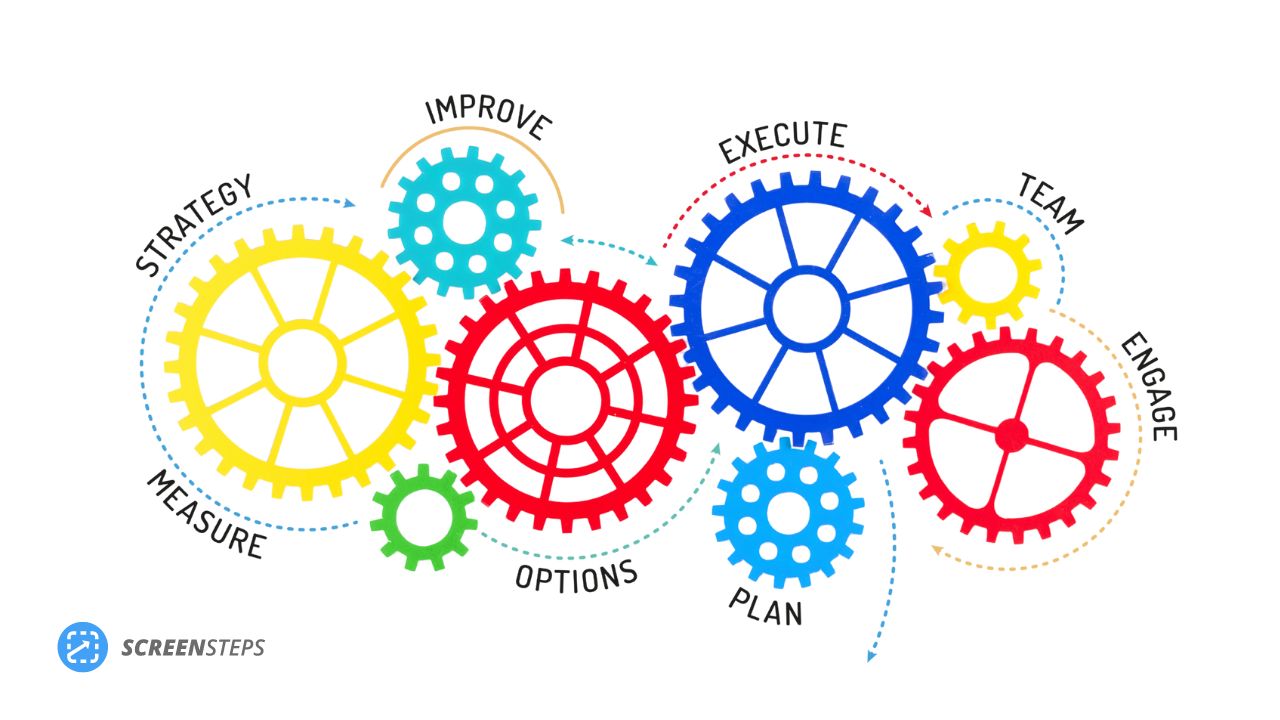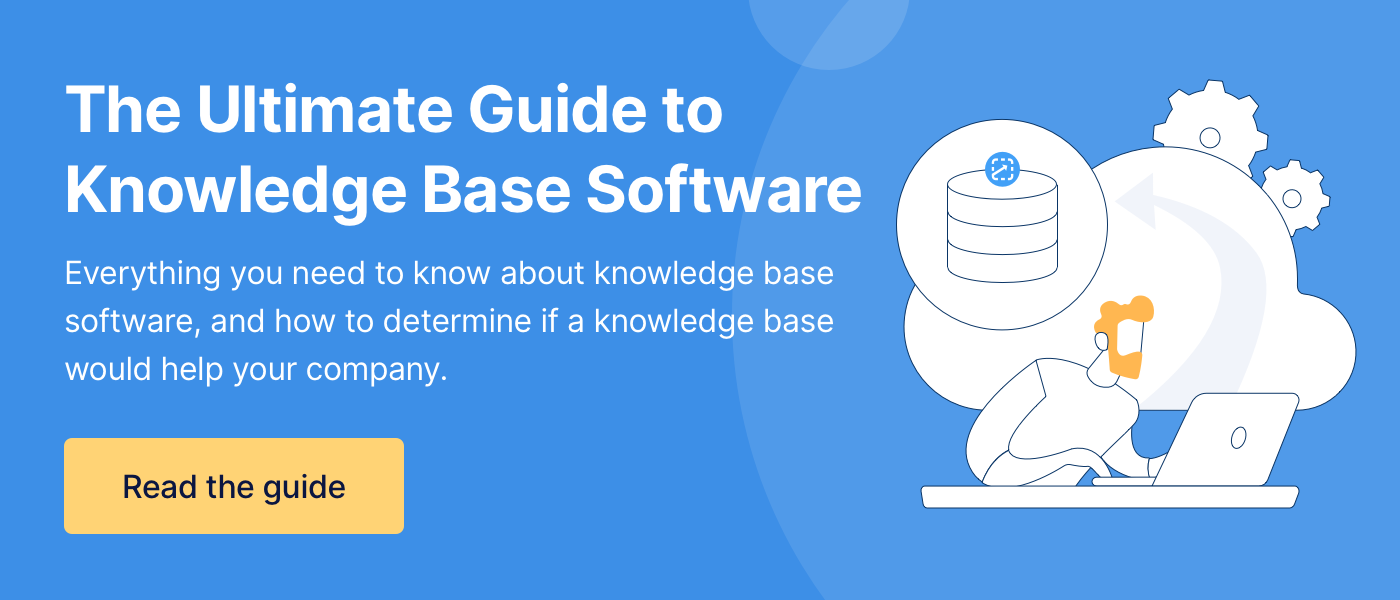Change can be exciting … but it can also be daunting.
Remember those first day of high school jitters? Yeah, those were from both excitement and fear. You finally got to be a “big kid” and have the high school experience. Yay! But now, everyone was older than you and the school was so much bigger, so you might get lost. Yikes!
Oddly enough, you can experience that same crossroad of nerves and energy as a full-grown adult implementing change in your business. But, luckily, this time around, you can have a roadmap.
Whether you are experiencing big or small changes, you need a change management strategy. A change management strategy helps make handling change in your organization run smoother.
Working for ScreenSteps — a knowledge base software and training solution company — I’ve seen how companies are more agile when they have a change management plan. Specifically, I’ve seen the benefits of businesses having a knowledge base and digital guides to communicate and handle change.
However, there are many different ways to handle change. And this blog post is dedicated to explaining all things change management.
Learn about the different types of change organizations face, why you need a change management plan, and how to handle change in your business.
What is change management?

Change management is the process of creating and implementing a plan that transitions a change within an organization.
Since change is an inevitable part of business, change management is used to help you improve effectiveness and adapt to new circumstances.
A change management strategy involves:
- Supporting employees
- Planning how to handle the change
- Obtaining buy-in from those involved in the change
- Implementing the change plan
- Monitoring and analyzing the success of the change
An effective change management strategy includes a clear goal or outcome for the change, careful planning, clear communication, and collaboration with stakeholders.
Change management vs. organizational change management
In some cases, people describe change management and organizational change management as different things. In those cases, change management is defined as the people side of change while organizational change management is the process side of change.
Ultimately, change management and organizational change management are the same thing. So, in this article, I will refer to change management and organizational change as the process of managing all types of change in your business.
🔎 Related: How ScreenSteps Prepares You to Manage Change
Different types of change in business
There are many different types of changes that a business needs to prepare for. The two most common types of change are adaptive and transformational change.
Adaptive vs transformational change
The two main areas that businesses experience change are adaptive and transformation change. Within each of these areas, there are sub-categories of change.
Adaptive change
Adaptive change is the small changes. They are incremental. These are the areas that don’t need a complete overhaul. Instead, they are minor changes that affect efficiency.
For example, you could add a step to a procedure or edit instructions to be easier for end-users to follow.
Specific changes that fit into adaptive change include small changes, including:
- Strategic change – Small changes to policies, processes, procedures, and workflows
- Unplanned change – Unexpected changes that companies need to react to in the moment (i.e. natural disasters, Covid-19, etc.)
- Remedial change – Operational changes that require immediate attention (i.e. addressing a customer communication issue or adding continuous learning to address knowledge gaps)
Transformational change
Transformational change is an expansive change. It’s a complete makeover or cultural shift. These are the types of changes that are considered dramatic.
Some sub-categories for transformational change include:
- Technological change – Adoption of new software or a digital transformation
- Personnel change – Expansion or reduction of people (i.e. onboarding new hires, merging of two or more companies, lay-offs)
- Structural change – Reorganizing your organization’s hierarchy
- Services change – Expansion of product (adding new products and services)
- Remedial change – If the issue is big enough, it will require immediate attention and require a large overhaul. This is why remedial change can be both adaptive and transformational.
Why organizations need change management
Running a business in the digital age means that companies need to be agile. Change is the only constant in business (and in life).
While specialized change management plans are created for transformational change, every business needs an adaptive change plan from the beginning. That’s because you’ll make tweaks to your policies and procedures regularly.
You need to be prepared for the inevitable change. If you put off creating a change management strategy, you will regret it when the first signs of change show.
Companies use a change management plan to:
- Fix problems
- Respond to market trends
- Grow as a business
- Stay competitive
- Keep knowledge up to date
- Reduce risk
Benefits of change management
When you have a change management plan, it sets a clear vision of where your company wants to go. It helps set up your expectations and articulate your company’s goals.
Other benefits of having a change management strategy include:
- Improve efficiency and effectiveness
- Ability to launch or initiate change faster
- Increase the likelihood of staying on budget
- Increase employee adoption
- Decrease risks (i.e. quality assurance)
- Increases chances of success with change
Challenges with change management
While change is inevitable, change can be hard — especially when you are dealing with people. Employees form habits that are difficult to break. They may initially prefer their old habits or the way they used to do things.
When you need to incorporate change, one of the biggest challenges is getting buy-in from everyone the change affects. Without buy-in, your change is less likely to stick or work.
Another challenge is that creating a change management plan takes a lot of time and energy. You need to figure out how you are going to implement that change, make those changes, communicate those changes with your employees, and initiate the change.
One common challenge and mistake is measuring the change. Before making a change, you want to capture metrics and KPIs (key performance indicators) so you can deduce whether a change has worked.
If you don’t capture that information before you begin, you will have to go off of how you feel, which is a weak measurement to present in a business meeting to your boss.
Which metrics should you capture? Check out these six KPIs to document before starting your change management project.
How to manage change (5 main stages)
Managing change means managing people, technology, and a process. As you build out your plan, you’ll need to account for all of these areas.
Here are five stages that will help you manage change. They provide a high-level overview — not a step-by-step guide — of what it takes to manage change in your business.
1. Define the change
Before you start taking action, you need to make sure everyone on your team is on the same page and that everyone is bought in to the change. You need to understand why you are making this change and what key results you hope this change will make in your business.
2. Plan the change
Once you have buy-in, you can create a strategy for how you are going to implement the change. Create a timeline with assignment deadlines and a goal launch date.
This phase includes researching and choosing any software tools that will support your change.
You’ll also want a communication plan to make sure your shareholders and impacted employees have clear expectations and an understanding of what is going to happen.
3. Design and prepare for change
Change doesn’t just happen. It takes a lot of preparation. You will create resources to help you roll out the change (i.e. training materials, employee support guides, etc.). This includes user acceptance testing for the materials you create.
4. Implement the change
With your resources ready, it's time to roll out the change. The implementation phase involves launching your program and/or software and training your employees who are affected by the change.
5. Monitor and reinforce the change
Throughout the implementation process and after the change has been implemented, track the progress of the change. Analyze the key performance indicators (KPIs) and measure your success to your goals.
Habits are difficult to break. When you implement a change, it is unfamiliar. Employees may default back to old habits. Reinforce the change so it will be completely adopted.
What tools do you need for an organizational change?
The tools you use to execute your change will depend on what type of change you are implementing in your business. Some options include:
- Digital adoption platform
- Project management tool
- Knowledge management software
- Knowledge base software
- Collaboration tools
- Training tools, like a Learning Management System
Handle any change with knowledge base software
Whether you are experiencing adaptive or transformational change, a knowledge base will help ease the challenges that come with change.
With an up-to-date knowledge base, it is easy to communicate and train your employees on procedural changes. You are providing them with digital guides to help them handle tasks.
With a ScreenSteps knowledge base, it takes mere minutes to update your digital guides. Then employees can find the guide they need in as few as two clicks. That makes updating employees about change a seamless experience.
Think a knowledge base could help you manage change (both big and small) in your business?
Learn more about knowledge base software with our ultimate guide to knowledge base software. In this guide, you’ll learn about the different types of knowledge bases, what problems a knowledge base helps solve, and what you should consider before purchasing knowledge base software.




